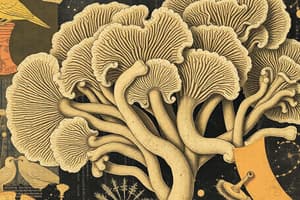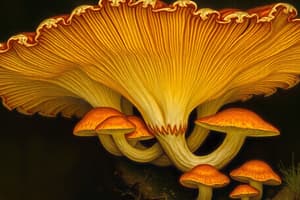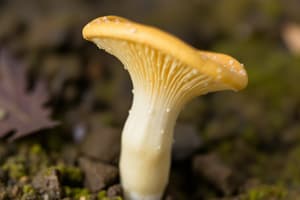Podcast
Questions and Answers
Explain how fungi are similar to and different from plants and animals.
Explain how fungi are similar to and different from plants and animals.
Similarities with plants: Like plants, fungi have cell walls (made of chitin), stay in one place and grow, and spread using spores. Similarities with animals: Fungi and animals are heterotrophic and release enzymes to break down food outside their bodies before absorbing it. Differences: Plants are autotrophic, have chlorophyll and cellulose, and are ingestive heterotrophs, while fungi are heterotrophic, have chitin, and are absorptive heterotrophs.
Like plants, fungi have cell walls, but they are made of cellulose.
Like plants, fungi have cell walls, but they are made of cellulose.
False (B)
Unlike plants, fungi have chlorophyll and cannot do photosynthesis.
Unlike plants, fungi have chlorophyll and cannot do photosynthesis.
True (A)
Plants are autotrophic while fungi are heterotrophic.
Plants are autotrophic while fungi are heterotrophic.
Describe the structure of multi celled fungi.
Describe the structure of multi celled fungi.
Explain how fungi meet their nutritional needs.
Explain how fungi meet their nutritional needs.
Describe the traits that distinguish chytrids.
Describe the traits that distinguish chytrids.
Describe the growth and reproduction of a zygote fungus.
Describe the growth and reproduction of a zygote fungus.
Explain how a microsporidian infects a host cell.
Explain how a microsporidian infects a host cell.
Describe the structure of a glomeromycota fungus.
Describe the structure of a glomeromycota fungus.
Describe the variety of growth forms in sac fungi.
Describe the variety of growth forms in sac fungi.
Explain the function of a sac fungus ascocarp and how this structure forms.
Explain the function of a sac fungus ascocarp and how this structure forms.
Describe the club fungus life cycle.
Describe the club fungus life cycle.
Compare the length of the dikaryotic phase in club fungi, sac fungi, and zygote fungi:
Compare the length of the dikaryotic phase in club fungi, sac fungi, and zygote fungi:
Using examples, describe the ways that fungi can benefit and harm other organisms.
Using examples, describe the ways that fungi can benefit and harm other organisms.
Describe the effects of two types of fungal infections common in humans.
Describe the effects of two types of fungal infections common in humans.
List some of the ways that humans use fungi.
List some of the ways that humans use fungi.
Flashcards
Hyphae
Hyphae
Tiny threads that make up multi-celled fungi, absorbing food from the soil. Form a network called mycelium.
Mycelium
Mycelium
A network formed by hyphae, serving as the main body and feeding structure of a fungus, absorbing nutrients.
Chytrids
Chytrids
Fungi that produce flagellated spores, single celled or form hyphae without cross walls
Yeasts
Yeasts
Signup and view all the flashcards
Ascocarp
Ascocarp
Signup and view all the flashcards
Club Fungi Dikaryotic Phase
Club Fungi Dikaryotic Phase
Signup and view all the flashcards
Fungi as Decomposers
Fungi as Decomposers
Signup and view all the flashcards
Athlete's foot
Athlete's foot
Signup and view all the flashcards
Yeast infection in mouth
Yeast infection in mouth
Signup and view all the flashcards
Human uses of fungi
Human uses of fungi
Signup and view all the flashcards
Study Notes
Fungal Traits and Diversity
- Fungi share similarities with plants, possessing cell walls made of chitin and remaining stationary while growing.
- Fungi spread through spores, similar to plant reproduction methods.
- Unlike plants, fungi lack chlorophyll and photosynthesis, obtaining food by breaking down organic matter, mirroring animal behavior.
- Fungi and animals are heterotrophic, relying on external organisms for sustenance.
- Fungi secrete digestive enzymes externally before absorbing nutrients, akin to animal digestion.
- Unlike autotrophic plants, fungi are heterotrophic.
- Plants contain chlorophyll and cellulose, while fungi have chitin in their cell walls.
- Animals are ingestive heterotrophs, whereas fungi are absorptive heterotrophs.
Multi-Celled Fungi Structure
- Multi-celled fungi consist of hyphae, which are tiny threads.
- Hyphae extend into the soil, facilitating nutrient absorption.
- Hyphae have cell walls and membranes.
- Mycelium, a network of hyphae, forms the main fungal body and is the feeding structure for nutrient absorption.
Fungi Nutritional Needs
- Fungi do not produce their own food.
- Fungi act as decomposers, breaking down plants and animals and returning nutrients to the soil.
- Parasitic fungi infect living organisms, causing diseases to acquire nutrients.
Flagellated Fungi (Chytrids)
- Chytrids produce flagellated spores for movement in water.
- Chytrids can be single-celled or form hyphae without cross walls.
- Chytrids function as decomposers and parasites, breaking down organic material and infecting plants and insects.
Zygote Fungi Growth
- Zygote fungi develop hyphae that extend across food sources to absorb nutrients.
- As hyphae spread, they form a mycelium network.
- Some hyphae grow upward, forming spore cases for reproduction.
Zygote Fungi Reproduction
- Fungi grow and reproduce asexually through spore formation (mitosis).
- Two fungi form branches (gametangia) that merge.
- Gametangia fusion creates a young zygospore with two nuclei.
- Nuclear fusion results in a mature diploid zygospore.
- Through meiosis, the zygospore creates haploid sexual spores that develop into new fungi.
Microsporidian Infection
- Microsporidians, parasites, infect insects, fish, and humans.
- Microsporidian spores enter a host's body.
- Spores form a polar tube.
- The polar tube penetrates the host cell, injecting the microsporidian contents.
- Inside the host cell, microsporidia consume nutrients and replicate.
- The infected cell bursts, releasing new spores that target additional cells or hosts.
Glomeromycota Fungi Structure
- Glomeromycetes fungi hyphae spread through soil and plant roots, helping the plant acquire nutrients.
- Fungi grow inside plant root cells, facilitating nutrient exchange.
Sac Fungi Growth Forms
- Tiny, single-celled yeasts grow and reproduce via budding.
Sac Fungi Ascocarp Function
- Asci form inside the ascocarp.
- Within the ascus, two nuclei combine to form a diploid zygote.
- The zygote undergoes meiosis, generating four haploid spores.
- Each spore undergoes mitosis, resulting in eight haploid spores.
- Spores are released, spreading the fungus.
Club Fungi Life Cycle
- Spores are released and initiate hyphal growth.
- Two hyphae fuse, forming a dikaryotic mycelium with two distinct nuclei per cell.
- The mycelium develops a fruiting body.
- Nuclei fuse, creating a diploid zygote within the gills.
- The diploid nucleus undergoes meiosis, generating haploid spores.
Dikaryotic Phase Length
- Club Fungi has the longest dikaryotic phase, potentially lasting for years as the fungus develops.
- Sac fungi dikaryotic phase occurs inside the fruiting body and lasts long enough to produce spores.
- Zygote fungi dikaryotic phase happens briefly within the zygosporangium before nuclei fuse.
Biological Roles of Fungi
- Fungi break down organic waste, releasing nutrients back into the soil for other organisms.
- Fungi form mutualistic relationships, such as mycorrhizal fungi sharing water and nutrients with plant roots.
- Some fungi, like rust and mildew, can infect and harm plants.
Fungal Infections in Humans
- Athlete's foot causes itchy, burning, and cracked skin.
- Yeast infections show white patches with soreness, itching, and redness in the mouth.
Human Uses of Fungi
- Fungi, like saccharomyces, are used for fermentation in wine, beer, and bread production.
- Aspergillus helps produce soy sauce.
Studying That Suits You
Use AI to generate personalized quizzes and flashcards to suit your learning preferences.




